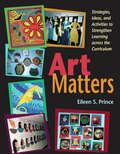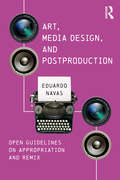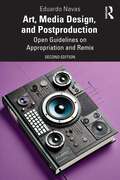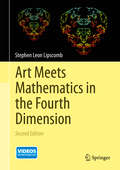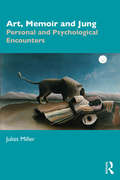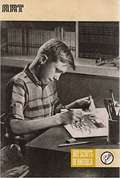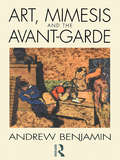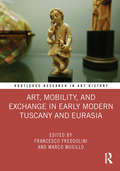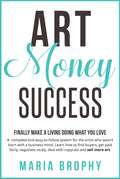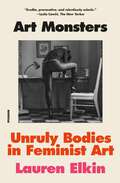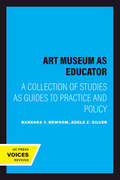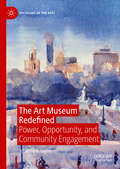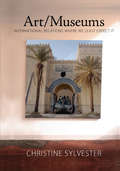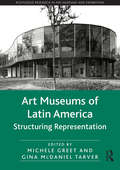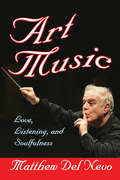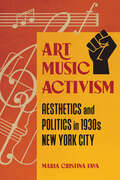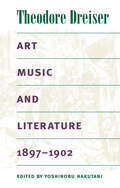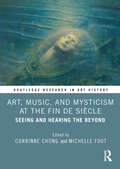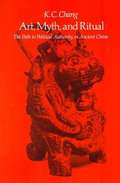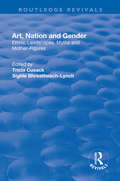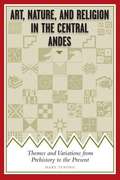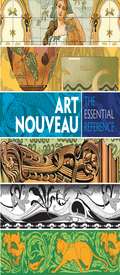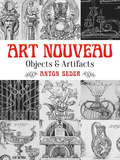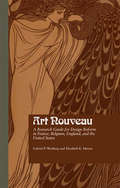- Table View
- List View
Art Matters: Strategies, Ideas, and Activities to Strengthen Learning Across the Curriculum
by Eileen PrinceThis collection of ideas and lesson plans will help classroom and homeschool teachers integrate art into their general curriculum. These inventive and effective methods use the visual arts to inspire creative writing and drama; explore math, music, science, and history; and cultivate critical thinking skills. Art instructors will learn strategies for incorporating other areas of study into the art classroom. Ranging from thought-provoking suggestions to concrete, hands-on lesson plans, these activities include an extensive resource list for classroom teachers without an art background.
Art, Media Design, and Postproduction: Open Guidelines on Appropriation and Remix
by Eduardo NavasArt, Media Design, and Postproduction: Open Guidelines on Appropriation and Remix offers a set of open-ended guidelines for art and design studio-based projects. The creative application of appropriation and remix are now common across creative disciplines due to the ongoing recycling and repurposing of content and form. Consequently basic elements which were previously exclusive to postproduction for editing image, sound and text, are now part of daily communication. This in turn pushes art and design to reconsider their creative methodologies. Author Eduardo Navas divides his book into three parts: Media Production, Metaproduction, and Postproduction. The chapters that comprise the three parts each include an introduction, goals for guidelines of a studio-based project, which are complemented with an explanation of relevant history, as well as examples and case studies. Each set of guidelines is open-ended, enabling the reader to repurpose the instructional material according to their own methodologies and choice of medium. Navas also provides historical and theoretical context to encourage critical reflection on the effects of remix in the production of art and design. Art, Media Design, and Postproduction: Open Guidelines on Appropriation and Remix is the first book of guidelines to take into account the historical, theoretical, and practical context of remix as an interdisciplinary act. It is an essential read for those interested in remix studies and appropriation in art, design and media.
Art, Media Design, and Postproduction: Open Guidelines on Appropriation and Remix
by Eduardo NavasA concise guide to the creative application of appropriation and remix that offers a set of open-ended guidelines for art and design studio-based projects, this book explores creativity with emerging technology, including artificial intelligence.This fully revised and expanded second edition engages with the ongoing recycling and repurposing of content and form, and the new directions the emerging form of metacreativity is taking art and design as artists continue to expand their creative methodologies. Exploration of metacreativity is new to this edition, with a focus on remix principles, the implementation of data analysis, and the delegation of parts of the creative process to automated algorithms and artificial intelligence. Each chapter includes an introduction, goals for guidelines of a studio-based project, with an explanation of relevant history, as well as examples and case studies. Each set of guidelines is open-ended, enabling the reader to repurpose the instructional material according to their own methodologies and choice of medium. Navas also provides historical and theoretical context to encourage critical reflection.The second edition remains the first book of guidelines to take into account the historical, theoretical, and practical context of remix as an interdisciplinary act. This is an essential read for those interested in remix studies and appropriation in art, design, and media.
Art Meets Mathematics in the Fourth Dimension
by Stephen Leon LipscombTo see objects that live in the fourth dimension we humans would need to add a fourth dimension to our three-dimensional vision. An example of such an object that lives in the fourth dimension is a hyper-sphere or "3-sphere. " The quest to imagine the elusive 3-sphere has deep historical roots: medieval poet Dante Alighieri used a 3-sphere to convey his allegorical vision of the Christian afterlife in his Divine Comedy. In 1917, Albert Einstein visualized the universe as a 3-sphere, describing this imagery as "the place where the reader's imagination boggles. Nobody can imagine this thing. " Over time, however, understanding of the concept of a dimension evolved. By 2003, a researcher had successfully rendered into human vision the structure of a 4-web (think of an ever increasingly-dense spider's web). In this text, Stephen Lipscomb takes his innovative dimension theory research a step further, using the 4-web to reveal a new partial image of a 3-sphere. Illustrations support the reader's understanding of the mathematics behind this process. Lipscomb describes a computer program that can produce partial images of a 3-sphere and suggests methods of discerning other fourth-dimensional objects that may serve as the basis for future artwork.
Art, Memoir and Jung: Personal and Psychological Encounters
by Juliet MillerIn this intimate study Juliet Miller maps the artworks that have influenced her throughout her life and examines how she has integrated them into her development as a psychotherapist. Working from the premise that our initial reactions to art provide a crucial key to self-analysis, Miller interrogates the significance of different artists, including Bourgeois, Vermeer, Rousseau and Kahlo, and analyses how personal circumstances, recollections and emotions have affected responses to their work. Chapters incorporate clinical material from Miller’s practice, linking into her own anxieties about sitting with and connecting with patients, and touching on themes including creativity, character, identity and communication. Through this exploration she questions many of the conventions of art and psychotherapy and suggests ways in which looking at art can be used as a psychological tool. Art, Memoir and Jung offers a highly personal and innovative perspective on meaning in art and how it can be used to explore Jungian thought as based in the aesthetic, and how the aesthetic can inform depth psychology.
Art (Merit Badge Series)
by Boy Scouts of AmericaThis book introduces scouts to the wonder of art in many of its forms.
Art, Mimesis and the Avant-Garde: Aspects of a Philosophy of Difference
by Andrew BenjaminFirst published in 1991. Routledge is an imprint of Taylor & Francis, an informa company.
Art, Mobility, and Exchange in Early Modern Tuscany and Eurasia (Routledge Research in Art History)
by Francesco Freddolini Marco MusilloThis book explores how the Medici Grand Dukes pursued ways to expand their political, commercial, and cultural networks beyond Europe, cultivating complex relations with the Ottoman Empire and other Islamicate regions, and looking further east to India, China, and Japan. The chapters in this volume discuss how casting a global, cross-cultural net was part and parcel of the Medicean political vision. Diplomatic gifts, items of commercial exchange, objects looted at war, maritime connections, and political plots were an inherent part of how the Medici projected their state on the global arena. The eleven chapters of this volume demonstrate that the mobility of objects, people, and knowledge that generated the global interactions analyzed here was not unidirectional—rather, it went both to and from Tuscany. In addition, by exploring evidence of objects produced in Tuscany for Asian markets,this book reveals hitherto neglected histories of how Western cultures projected themselves eastwards.
Art Money Success: Finally Make a Living Doing What You Love
by Maria BrophyFINALLY MAKE A LIVING DOING WHAT YOU LOVE Why is it that some artists are wildly successful, while others just barely squeak by? It may seem like an unfathomable mystery, how some are earning six figures while other, more talented artists, are struggling. Maria Brophy has dedicated 20 years of her life to researching the specific strategies that successful artists follow. After applying these strategies to her husband Drew Brophy's career, Maria grew his art sales to multiple six-figures yearly. In ART MONEY SUCCESS, Maria tells personal stories of her own business deals, successes and failures, while sharing non-conventional wisdom that will explode your art sales. With the exercises and worksheets included, you can apply the insights to your own business for immediate results. The tools inside will help you: - Connect with your right buyers - Increase your $$$ income today - Sell art easily and negotiate nicely - License your art and get paid multiple times - Implement powerful money and business practices - Trust your own creative intuition If you are interested in generating more money and success from your art, then this book is for you! "A lot of people tell me that I should sell my work, but Maria Brophy is the first person who has been able to tell me how, in a viable way." -Joe Mahoney
Art Monsters: Unruly Bodies in Feminist Art
by Lauren ElkinA Must-Read: Vogue, Nylon, Chicago Review of Books, Literary Hub, Frieze, The Millions, Publishers Weekly, InsideHook, The Next Big Idea Club,“[Lauren] Elkin is a stylish, determined provocateur . . . Sharp and cool . . . [Art Monsters is] exemplary. It describes a whole way to live, worthy of secret admiration.” —Maggie Lange, The Washington Post“Destined to become a new classic . . . Elkin shatters the truisms that have evolved around feminist thought.” —Chris Kraus, author of I Love Dick and After Kathy Acker: A Literary BiographyWhat kind of art does a monster make? And what if monster is a verb? Noun or a verb, the idea is a dare: to overwhelm limits, to invent our own definitions of beauty.In this dazzlingly original reassessment of women’s stories, bodies, and art, Lauren Elkin—the celebrated author of Flâneuse—explores the ways in which feminist artists have taken up the challenge of their work and how they not only react against the patriarchy but redefine their own aesthetic aims. How do we tell the truth about our experiences as bodies? What is the language, what are the materials, that we need to transcribe them? And what are the unique questions facing those engaged with female bodies, queer bodies, sick bodies, racialized bodies? Encompassing a rich genealogy of work across the literary and artistic landscape, Elkin makes daring links between disparate points of reference—among them Julia Margaret Cameron’s photography, Kara Walker’s silhouettes, Vanessa Bell’s portraits, Eva Hesse’s rope sculptures, Carolee Schneemann’s body art, Theresa Hak Kyung Cha’s trilingual masterpiece DICTEE—and steps into the tradition of cultural criticism established by Susan Sontag, Hélène Cixous, and Maggie Nelson. An erudite, potent examination of beauty and excess, sentiment and touch, the personal and the political, the ambiguous and the opaque, Art Monsters is a radical intervention that forces us to consider how the idea of the art monster might transform the way we imagine—and enact—our lives.
The Art Museum as Educator: A Collection of Studies as Guides to Practice and Policy
by Barbara Y. Newsom Adele Z. SilverThis title is part of UC Press's Voices Revived program, which commemorates University of California Press’s mission to seek out and cultivate the brightest minds and give them voice, reach, and impact. Drawing on a backlist dating to 1893, Voices Revived makes high-quality, peer-reviewed scholarship accessible once again using print-on-demand technology. This title was originally published in 1978.
The Art Museum Redefined: Power, Opportunity, and Community Engagement (Sociology of the Arts)
by Johanna K. TaylorThis book presents a critical analysis of the power and opportunity created in the implementation of community engaged practices within art museums, by looking at the networks connecting art museums to community organizations, artists and residents. The Art Museum Redefined places the interaction of art museums and urban neighbourhoods as the central focus of the study, to investigate how museums and artists collaborate with residents and local community groups. Rather than defining the community solely from the perspective of a museum looking out at its audience, the research examines the larger networks of art organizing and creative activism connected to the museum that are active across the neighbourhood. Taylor's research encompasses the grassroots efforts of local groups and their collaboration with museums and other art institutions that are extending their reach outside their physical walls and into the community. This focus on social engagement speaks to recent emphasis in cultural policy on cultural equity and inclusion, creative place-making and community engagement at neighbourhood and city-levels, and will be of interest to students, scholars and policy-makers alike.
Art/Museums: International Relations Where We Least Expect it (Media and Power)
by Christine SylvesterArt/Museums takes the study of international relations to the art museum. It seeks to persuade those who study international relations to take art/museums seriously and museum studies to take up the insights of international relations. And it does so at a time when both international relations and art are said to be at an end-that is, out of control and beyond sight of their usual constituencies. The book focuses on the British Museum, the National Gallery of London, the Museum of Iraq, the Museum of Modern Art in New York, the Getty museums, the Guggenheim museums, and "museum" spaces instantly created by the attacks on the World Trade Center in 2001. The art includes works over which museums might struggle, acquire through questionable means, hoard and possibly lose, such as the Parthenon sculptures, Raphael's Madonna of the Pinks, the ancient art of Babylon, modern art, and the art/museum itself in an era of rapid museum expansion. Bringing art, museums, and international relations together draws on the art technique of collage, which combines disparate objects, themes, and time periods in one work to juxtapose unexpected elements, leaving the viewer to relate objects that are not where they are expected to be.
Art Museums of Latin America: Structuring Representation (Routledge Research in Art Museums and Exhibitions)
by Michele Greet Gina McDaniel TarverSince the late nineteenth century, art museums have played crucial social, political, and economic roles throughout Latin America because of the ways that they structure representation. By means of their architecture, collections, exhibitions, and curatorial practices, Latin American art museums have crafted representations of communities, including nation states, and promoted particular group ideologies. This collection of essays, arranged in thematic sections, will examine the varying and complex functions of art museums in Latin America: as nation-building institutions and instruments of state cultural politics; as foci for the promotion of Latin American modernities and modernisms; as sites of mediation between local and international, private and public interests; as organizations that negotiate cultural construction within the Latin American diaspora and shape constructs of Latin America and its nations; and as venues for the contestation of elitist and Eurocentric notions of culture and the realization of cultural diversity rooted in multiethnic environments.
Art Music: Love, Listening and Soulfulness
by Matthew Del NevoListening to music is not merely something one does, but something central to a way of living. Listening has the power to transport one into another way of being. It is a mode of feeling and forms the bedrock of deep emotion. Written from the viewpoint of a philosophy of sensibility, Matthew Del Nevo notes that this perspective may not be in fashion, but it follows a long tradition.Del Nevo emphasizes the aesthetic experience of listening to art music as it has developed and disintegrated in Western civilization. He recognizes a deep psychological element to what he calls soul—or more accurately sensibility. He addresses music in a non-technical way, taking up the powerful art theory of Charles Baudelaire, the music philosophy of Schopenhauer and Richard Wagner, and takes a strong critical stand against modernist intellectual art music.The importance of this book for the musically- literate reader is its insight into the metaphysics of nostalgia. This comprehension is missing from nearly all musical instruction because we have lost sight of it. Del Nevo asserts that this understanding must be brought back into our culture. And since this is a book about listening to art music, it is no less about sensibility and its cultivation, which in its object form we call culture. An engaging book, Art Music will appeal to those interested in music, culture, and philosophy.
Art Music Activism: Aesthetics and Politics in 1930s New York City (Music in American Life)
by Maria Cristina FavaSurrounded by the widespread misery of the Depression, left-leaning classical music composers sought a musical language that both engaged the masses and gave voice to their concerns. Maria Cristina Fava explores the rich creative milieu shaped by artists dedicated to using music and theater to advance the promotion, circulation, and acceptance of leftist ideas in 1930s New York City. Despite tensions between aesthetic and pragmatic goals, the people and groups produced works at the center of the decade’s sociopolitical and cultural life. Fava looks at the Composers’ Collective of New York and its work on proletarian music and workers’ songs before turning to the blend of experimentation and vernacular idioms that shaped the political use of music within the American Worker’s Theater Movement. Fava then reveals how composers and theater practitioners from these two groups achieved prominence within endeavors promoted by the Works Project Administration. Fava’s history teases out fascinating details from performances and offstage activity attached to works by composers such as Marc Blitzstein, Charles Seeger, Ruth Crawford Seeger, Elie Siegmeister, and Harold Rome. Endeavors encouraged avant-garde experimentation while nurturing innovations friendly to modernist approaches and an interest in non-western music. Blitzstein’s The Cradle Will Rock offered a memorable example that found popular success, but while the piece achieved its goals, it became so wrapped up in myths surrounding workers’ theater that critics overlooked Blitzstein’s musical ingenuity. Provocative and original, Art Music Activism considers how innovative classical composers of the 1930s balanced creative aims with experimentation, accessible content, and a sociopolitical message to create socially meaningful works.
Art, Music, and Literature, 1897-1902
by Theodore DreiserDreiser's captivating portraits of turn-of-the-century America's famous figures In this volume, liberally seasoned with period illustrations, Yoshinobu Hakutani has collected and annotated a rich selection of Theodore Dreiser's pre-fame writings on the cultural milieu of his day. In these brief essays, Dreiser sallies into the vibrant world of creative work in turn-of-the-century America. He inspects the eccentric and revealing paraphernalia of artists' studios, probes the work habits of writers, and goes behind the scenes in the popular song-writing business, where this week's celebrity is next week's has-been. He profiles famous figures and introduces numerous women artists, novelists, and musicians, including the prolific and tireless Amelia Barr (mother of fourteen children and author of thirty-two novels), the illustrator Alice B. Stephens, and the opera singer Lillian Nordica. Hakutani's notes provide biographical detail on dozens of now-obscure individuals mentioned by Dreiser.
Art, Music, and Mysticism at the Fin de Siècle: Seeing and Hearing the Beyond (Routledge Research in Art History)
by Michelle Foot Corrinne ChongThis edited volume explores the dialogue between art and music with that of mystical currents at the turn of the twentieth century. The volume draws on the most current research from both art historians and musicologists to present an interdisciplinary approach to the study of mysticism’s historical importance. The chapters in this edited volume gauge the scope of different interpretations of mysticism and illuminate how an exchange between the sister arts unveil an underlying stream of metaphysical, supernatural, and spiritual ideas over the course of the century. Case studies include Charles Tournemire, Joseph Péladan, Erik Satie, Hilma af Klint, Jean Sibelius, František Kupka, and Wassily Kandinsky. The contributors’ unique theoretical perspectives and disciplinary methodologies offer expert insight on both the rewards and inevitable aesthetic complications that arise when one artform meets another. The book will be of interest to scholars working in art history, musicology, visual culture, and mysticism.
Art, Myth And Ritual: The Path to Political Authority in Ancient China
by K. C. ChangLeading scholar K. C. Chang challenges long-standing conceptions of the rise of political authority in ancient China. This book is a persuasive demonstration of the importance of an interdisciplinary approach to the study of early civilizations.
Art, Nation and Gender: Ethnic Landscapes, Myths and Mother-Figures
by Sighle Bhreathnach-LynchThis title was first published in 2003. The essay collection explores the conjunctions of nation, gender, and visual representation in a number of countries-including Ireland, Scotland, Britain, Canada, Finland, Russia and Germany-during the nineteenth and twentieth centuries. The contributors show visual imagery to be a particularly productive focus for analysing the intersections of nation and gender, since the nation and nationalism, as abstract concepts, have to be "embodied" in ways that make them imaginable, especially through the means of art. They explore how allegorical female figures personify the nation across a wide range of visual media, from sculpture to political cartoons and how national architectures may also be gendered. They show how through such representations, art reveals the ethno-cultural bases of nationalisms. Through the study of such images, the essays in this volume cast new light on the significance of gender in the construction of nationalist ideology and the constitution of the nation-state. In tackling the conjunctions of nation, gender and visual representation, the case studies presented in this publication can be seen to provide exciting new perspectives on the study of nations, of gender and the history of art. The range of countries chosen and the variety of images scrutinised create a broad arena for further debate.
Art, Nature, and Religion in the Central Andes: Themes and Variations from Prehistory to Present
by Mary StrongFrom prehistory to the present, the Indigenous peoples of the Andes have used a visual symbol system—that is, art—to express their sense of the sacred and its immanence in the natural world. Many visual motifs that originated prior to the Incas still appear in Andean art today, despite the onslaught of cultural disruption that native Andeans have endured over several centuries. Indeed, art has always been a unifying power through which Andeans maintain their spirituality, pride, and culture while resisting the oppression of the dominant society. In this book, Mary Strong takes a significantly new approach to Andean art that links prehistoric to contemporary forms through an ethnographic understanding of Indigenous Andean culture. In the first part of the book, she provides a broad historical survey of Andean art that explores how Andean religious concepts have been expressed in art and how artists have responded to cultural encounters and impositions, ranging from invasion and conquest to international labor migration and the internet. In the second part, Strong looks at eight contemporary art types—the scissors dance (danza de tijeras), home altars (retablos), carved gourds (mates), ceramics (ceramica), painted boards (tablas), weavings (textiles), tinware (hojalateria), and Huamanga stone carvings (piedra de Huamanga). She includes prehistoric and historic information about each art form, its religious meaning, the natural environment and sociopolitical processes that help to shape its expression, and how it is constructed or performed by today’s artists, many of whom are quoted in the book.
Art Not by Eye: The Previously Sighted Visually Impaired Adult in Fine Arts Programs
by Yasha LisencoThe book, in two parts, deal with avenues for adventitiously blind adult, and the blind and severely visually impaired adults in the art program.
Art Nouveau: The Essential Reference (Dover Pictura Electronic Clip Art Ser.)
by Carol Belanger Grafton"This is a gorgeous book, ideal for any lover of Art Nouveau." --bookaddictionDover's extensive library of Art Nouveau graphic art and typography serves as the source for this comprehensive volume, which features hundreds of magnificent full-color and black-and-white illustrations. Images by virtually every key artist of the Art Nouveau movement include the work of Alphonse Mucha, E. A. Seguy, Aubrey Beardsley, Koloman Moser, Max Benirschke, and M. P. Verneuil. Selections from rare books and portfolios of the period include works never reprinted since their initial publication. This book also reprints material from the major Art Nouveau periodicals, including Jugend, The Studio, Dekorative Vorbilder, and The Keramic Studio. Detailed bibliographical information concerning every source - including biographical details of each artist - makes this collection a vital reference tool as well as a stunning compendium of significant and beautiful Art Nouveau graphics. Students of graphic art, typography, and illustration, as well as graphic designers and advertising professionals, will prize this remarkable resource.
Art Nouveau: Objects and Artifacts (Dover Pictorial Archive)
by Anton SederA revolutionary reaction to the eclectic historical styles of nineteenth-century art, the turn-of-the-century Art Nouveau movement drew much of its inspiration from nature. Applying its sinuous, curvilinear motifs to the decorative arts, graphics, architecture, sculpture, and painting, artists and crafters attempted to create a style suitable for a "modern" age. This treasury of rare Art Nouveau decorative ornaments offers an unusual selection of the genre's most strikingly imaginative graphics. Originally published in Paris in 1899 and sold by subscription, the collection features fifty full-page plates depicting a rich profusion of everyday items rendered in the distinctive Art Nouveau style. Intricate patterns of flowers, vines, faces, and other designs decorate scores of objects made of metal, ceramic, and glass: pitchers and vases, cutlery, walking sticks, jewelry, and other objects and artifacts. A source of authentic Art Nouveau graphics, this compilation will serve as an inspiration for artists, illustrators, and designers.
Art Nouveau: A Research Guide for Design Reform in France, Belgium, England, and the United States
by Gabriel P. Weisberg Elizabeth K. MenonFirst published in 1998. Routledge is an imprint of Taylor & Francis, an informa company.
